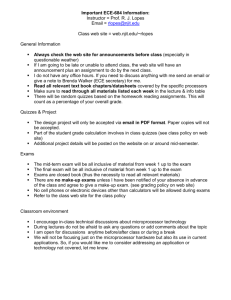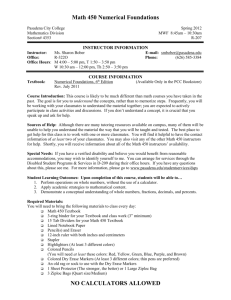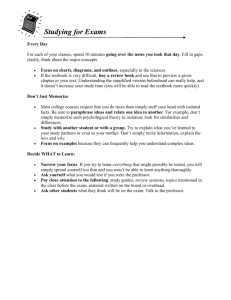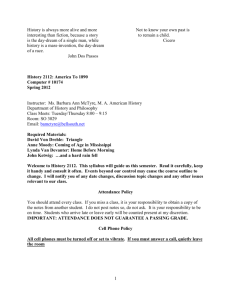Syllabus - BYU Independent Study
advertisement
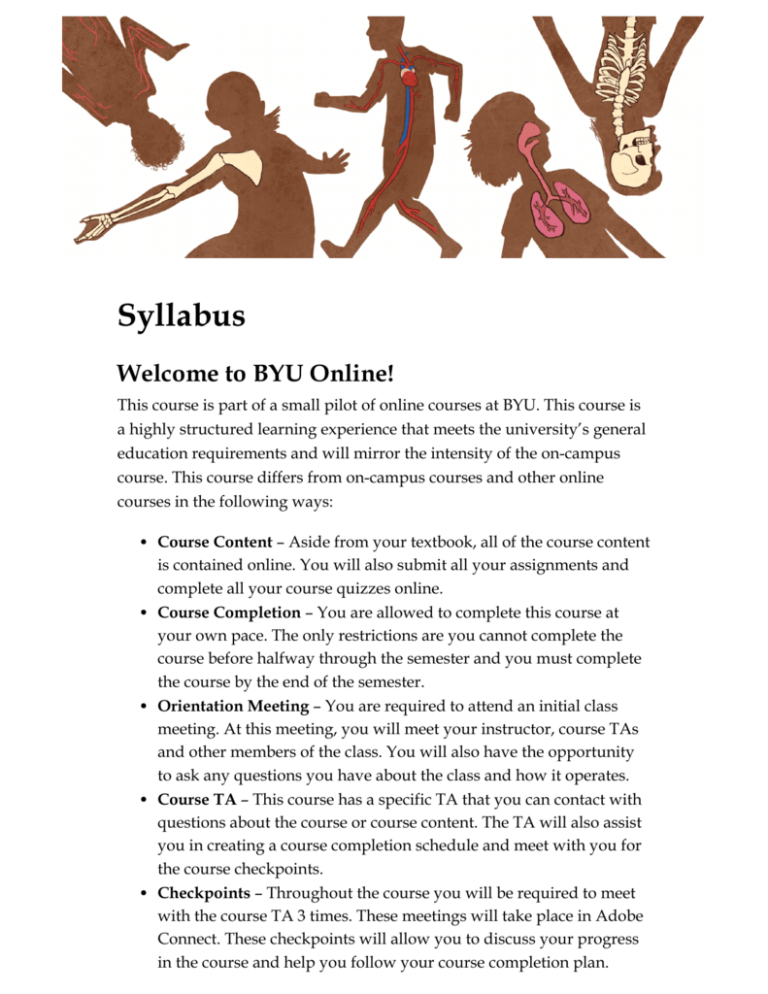
Syllabus Welcome to BYU Online! This course is part of a small pilot of online courses at BYU. This course is a highly structured learning experience that meets the university’s general education requirements and will mirror the intensity of the on­campus course. This course differs from on­campus courses and other online courses in the following ways: Course Content – Aside from your textbook, all of the course content is contained online. You will also submit all your assignments and complete all your course quizzes online. Course Completion – You are allowed to complete this course at your own pace. The only restrictions are you cannot complete the course before halfway through the semester and you must complete the course by the end of the semester. Orientation Meeting – You are required to attend an initial class meeting. At this meeting, you will meet your instructor, course TAs and other members of the class. You will also have the opportunity to ask any questions you have about the class and how it operates. Course TA – This course has a specific TA that you can contact with questions about the course or course content. The TA will also assist you in creating a course completion schedule and meet with you for the course checkpoints. Checkpoints – Throughout the course you will be required to meet with the course TA 3 times. These meetings will take place in Adobe Connect. These checkpoints will allow you to discuss your progress in the course and help you follow your course completion plan. Webinars – A webinar is a scheduled class session that you will attend through Adobe Connect. These webinars will allow for information sharing, special lectures, guest lectures and exam reviews. You will be able to interact with your instructor and other members of the class. Discussion Board – This course contains a monitored course discussion board. This discussion board will allow you to post, respond to and evaluate various topics related to the course material. As part of the pilot, we will be asking you to help assess the success and effectiveness of this course, the faculty member, the course delivery and the course support. Your participation in this assessment effort will be critical to future opportunities for online learning at BYU. Please be prepared to provide meaningful feedback about your experience. Course TA Information Your TAs for this course are Marc Matsumura and Mikele Stephenson. Please contact your TAs if you have any questions, run into difficulties with the course, and to schedule checkpoints. Marc Matsumura and Mikele Stephenson ta_pdbio210@byu.edu 801­422­2776 Click here to watch video. © BYU Independent Study Click here to watch video. © BYU Independent Study Remember, your TA is your first line of contact, and will be able to help you with most issues that come up. He is looking forward to getting to know you! Course Overview You will learn, in quite some detail, the structural nature and significance of each of the major organ systems, and how each system carries out its unique role in the living organism. You will come to a greater appreciation of some of the clinical concerns in keeping your body alive and functioning well. You will also understand the procreation process and the miracle of life as a human develops from a single microscopic cell called the zygote. The result of this developmental process is a multicellular organism that has the ability to perform such marvelous physiological, physical, and mental feats as eating, running, thinking, and reasoning— and even comprehending PDBIO 210. You may be wondering how a laboratory experience for this science course will be fulfilled. We will do our best to present the material through video presentations, the Anatomy Laboratory Manual, and the Human Anatomy textbook in a manner that will help you learn it. With a front­row seat, you will have the opportunity of being instructed by a teaching assistant (TA) who will use models, charts, and human cadavers to help identify anatomical structure. As you study the body, you will discover its intricate design and come to a greater appreciation of it and what a marvelous creation it is. This course is designed so that your grade will reflect how much effort you put forth. There are three steps that will help you learn the material and prepare to take the exams: Follow the instructions at the beginning of each lesson, paying particular attention to the objectives. Read the assigned chapters in both the textbook and laboratory manual and view the video presentations. Review the material by completing the Discussion Material, the Self Check questions, and the quizzes. BYU Course Outcomes 1. Tissue Structures Students will demonstrate an understanding of the basic microscopic underpinnings of tissue structures and be able to name them. 2. The Human Body Students will demonstrate a greater understanding and appreciation for the human body, it’s overall design and connections to other living organisms, and what a marvelous creation it is. Course Learning Outcomes 1. Overall Goal Students will develop a greater understanding and appreciation for the human body. As the anatomical structures of the body are studied, the students will discover the body’s design and come to a greater appreciation of it and what a marvelous creation it is. 2. Learning Outcomes a. Students will be able to demonstrate their knowledge of human anatomy by proficient performance on exams that test the names, location, and function of each of the body’s organs and organ systems, thereby preparing them for success in future courses and for success in health­related professions. b. Students will demonstrate an understanding of the basic microscopic underpinnings of tissue structures and be able to name them. c. Students will demonstrate a greater understanding and appreciation for the human body, its overall design and connections to other living organisms, and what a marvelous creation it is. d. Students will be able to list the name, location, and function of each of the body’s organs and organ systems. Course Materials Textbook and Access Code You will need to purchase access to ConnectPlus (http://connect.mcgraw­ hill.com/connect/shortUrl.do?accessUrl=m_stark_001_1) and a version of the textbook Human Anatomy, 4th edition (2014), by Michael McKinley, Valerie O'Loughlin, Ronald Harris, Elizabeth Pennefather­O'Brien McKinley. Please be aware that earlier textbook editions (or a different textbook altogether) will not match this course. Should you chose to use one, you will need to buy Connect Plus/APR access for the 4th edition in addition to it. You have a number of options from which to choose: E­book with access code: ConnectPlus Code for Human Anatomy, 4th edition, by Michael McKinley and Valerie Dean O'Loughlin; McGraw­Hill (2014). (ISBN 9781259333989; 1­year access) Note: When you buy the access code, you get access to the e­ book along with it. Loose­leaf with access code and e­book: Human Anatomy (with ConnectPlus access code), 4th edition, by Michael McKinley and Valerie Dean O'Loughlin; McGraw­Hill (2014). (ISBN 9781259334023; 1­year access) Hardcover with access code and e­book: Human Anatomy, 4th edition, by Michael McKinley and Valerie Dean O'Loughlin; McGraw­Hill (2014). (ISBN 9781259334016; 1­year access) As you read each chapter, pay particular attention to the bold­face headings and descriptive terms. Use the lesson introductions to help you focus on the salient features of each lesson and also to help assess your comprehension. You will learn that anatomy has its own beautiful language based on Latin and Greek descriptive terms. Refer to the glossary in your textbook or lab manual to assist with some of the more difficult terms. Note that all organs have a functional purpose and are interdependent. Also note that levels of organization exist in the body—a hierarchy from submicroscopic molecular particles to the much larger cellular, tissue, and organ structures. MyContent Course Code: ghWM3 Laboratory Manual The laboratory manual, Human Anatomy Laboratory Manual 2013 Edition, developed by BYU's Physiology and Developmental Biology Department, is also required for this course. It is provided in PDF format in your course (in the Human Anatomy Laboratory Manual and Virtual Lab section of your course). You may purchase a printed copy of it from BYU Bookstore if you'd like, but that version has a slightly different organization, so it may be more challenging to use. You will use the laboratory manual in lessons 5, 6, 8, 9, 11, 12, 13, 14, 15, 16, 17, 18, and 19. Virtual Human Anatomy Laboratory The Virtual Human Anatomy Laboratory is a series of videos that will guide you through learning the major anatomical features of the human body. Watch them and review them often. These videos are located in the Human Anatomy Laboratory Manual and Virtual Lab section of your course. Study hint: For practice, try turning off the volume and naming the parts as the virtual TA points them out. Course Organization Course Deadlines You must complete the following exams by the deadlines stated below. Deadline Sept. 12 Quiz/Exam Quiz 1, 2, 3 Sept. 26 Quiz 4, 5, 6 Oct. 10 Quiz 7, 8, 9 Sept. 21 ­ Oct. 16 Content Midterm Exam** Oct. 24 Quiz 10, 11 Sept. 21 ­ Oct. 30 Lab Midterm Exam** Nov. 7 Quiz 12, 13 Nov. 21 Quiz 14, 15, 16 Dec. 4 Quiz 17, 18 Dec. 11 Quiz 19 Nov. 2 ­ Dec. 18 Content Final Exam** Lab Final Exam** *All quizzes will be due at 11:59 PM on date indicated **All exams must be scheduled at least 48 hours in advance and can be taken at anytime Quizzes There are a total of 19 quizzes, one for each lesson in this course. The lowest score will be dropped, so only 18 of them will count towards your final grade. I recommend that you study and prepare for each quiz and treat it as an opportunity to practice for the exams. You will be able to take each quiz only once. Self Check Practice Questions Some of the lessons will have Self Check questions for you to test your knowledge and help you practice for the quizzes and exams. These do not count as part of your grade. Please take advantage of them to enhance your studies! The midcourse laboratory exam and the midcourse content exam both have practice exams to help you get a feel for what the exams will be like. They will consist of 20 questions taken from your lesson quizzes and the midcourse exams. You will have 20 minutes to take these practice exams, so you will not have time to look up the answers. (While the actual exams are not time, making these practice exams timed will help you practice more effectively.) You can take the practice exams as many times as you would like and they do not count as part of your grade. Exams Midcourse Exams There are two midcourse exams: an instructor­graded anatomical terms (laboratory) exam and a computer­graded content exam. The content midcourse exam will have multiple­choice questions covering lessons 1 through 9 and the associated chapters in your textbook. The anatomical terms (laboratory) exam comes after lesson 11 and will consist of color photos of anatomical parts with specific, possibly highlighted, features indicated. You will need to identify these anatomical parts using the full name, correctly spelled. The question format will be fill­in­the­blank, but you will write your answers on a separate piece of paper which will be provided with your exam. As mentioned above, there are practice exams for each midcourse exam that do not count towards your grade. Please take advantage of the opportunity to practice! Final Exams Similar to the two midcourse exams, there are two final exams: an instructor­graded anatomical terms (laboratory) exam and a computer­ graded content exam. You will need to complete the final lab exam before you can request the final content exam. (There are no practice exams for the final exam.) The anatomical terms (laboratory) exam will consist of color photos of anatomical parts with specific features indicated. You will need to identify these anatomical parts using the correctly spelled full name. The question format will be fill­in­the­blank, but you will write your answers on a separate piece of paper which will be provided with your exam when you are taking a proctored, written exam. The content final exam is comprehensive. It is composed of 125 multiple­ choice questions with the majority of those questions based on material covered in the second half of the course (which includes lessons 10 through 19 with their associated chapters in your textbook). You must pass the final exam with at least a 50% to pass this course. Please note: BYU standards expect English language proficiency for all courses, including Independent Study courses. Therefore dictionaries of any kind will not be allowed for testing. Grading Your grade will be based on this breakdown: 18* Quizzes 36% Midcourse Content Exam 13% Midcourse Laboratory (Anatomical Terms) Exam 13% Final Laboratory (Anatomical Terms) Exam 13% Final Content Exam 24% Total 100% *The lowest score of 19 quizzes is dropped. Grading Scale Your final grade will be determined by the following grading scale. Grading Scale A 100–94% A­ 93­89% B+ 88­85% B 84­81% B­ 80­77% C+ 76­73% C 72­70% C 72­70% C­ 69­66% D+ 65­61% D 60­56% D­ 55­51% E (fail) 50% and below

